003:对象原理下-isa指针(isa[联合体位域]->class、bits->shiftcls)
问题
1:_objc_initInstanceIsa的流程三部曲
2:isa为什么是8字节
3:isa流程图
目录
1:oc对象本质
2:探索objc_setProperty原理
3:结构体和联合体位域
4:源码查找isa指针
5:isa指针位域具体信息
6:isa关联地址和类的过程
7:关联的验证
8:isa走向图
预备
1:LLVM与clang
LLVM是构架编译器(compiler)的框架系统,以C++编写而成,用于优化以任意程序语言编写的程序的编译时间(compile-time)、链接时间(link-time)、运行时间(run-time)以及空闲时间(idle-time),对开发者保持开放,并兼容已有脚本。Clang是一个C++编写、基于LLVM、发布于LLVM BSD许可证下的C/C++/Objective-C/Objective-C++编译器。比起GCC,Clang编译速度快、占用内存小、非常方便进行二次开发。
下图是LLVM和Clang的关系图

1. Clang相当于编译过程的前端,而LLVM相当于编译过程的后端。
2. Clang侧重于
语法语义分析和生成中间代码,而LLVM侧重于代码优化,生成目标程序。3.clang命令编译mian.c的指令:
clang -rewrite-objc main.m -o main.cpp2:利用
clang将main.m编译成 main.cpp,有以下几种编译命令,//1、将 main.m 编译成 main.cpp clang -rewrite-objc main.m -o main.cpp //2、将 ViewController.m 编译成 ViewController.cpp clang -rewrite-objc -fobjc-arc -fobjc-runtime=ios-13.0.0 -isysroot / /Applications/Xcode.app/Contents/Developer/Platforms/iPhoneSimulator.platform/Developer/SDKs/iPhoneSimulator13.7.sdk ViewController.m //以下两种方式是通过指定架构模式的命令行,使用xcode工具 xcrun //3、模拟器文件编译 - xcrun -sdk iphonesimulator clang -arch arm64 -rewrite-objc main.m -o main-arm64.cpp //4、真机文件编译 - xcrun -sdk iphoneos clang -arch arm64 -rewrite-objc main.m -o main- arm64.cpp
正文
1: OC对象的本质
1.1:首先我们定义一个对象
@interface FYPerson : NSObject @property (nonatomic, copy) NSString *name; @end @implementation FYPerson @end
2:通过终端利用clang将main.m编译成 main.cpp
3:打开编译好的main.cpp,找到FYPerson的定义,可以看到FYPerson在底层会被编译成 struct 结构体
声明的底层编译
//NSObject的定义 @interface NSObject <NSObject> { Class isa OBJC_ISA_AVAILABILITY; } //NSObject 的底层编译 struct NSObject_IMPL { Class isa; }; //FYPerson的底层编译 struct FYPerson_IMPL { struct NSObject_IMPL NSObject_IVARS; // 等效于 Class isa; NSString *_name; };
实现的底层编译
struct FYPerson_IMPL { struct NSObject_IMPL NSObject_IVARS; NSString *_name; }; // @property (nonatomic, copy) NSString *name; /* @end */ // @implementation FYPerson //这是get方法 static NSString * _I_FYPerson_name(FYPerson * self, SEL _cmd) { return (*(NSString **)((char *)self + OBJC_IVAR_$_FYPerson$_name)); } extern "C" __declspec(dllimport) void objc_setProperty (id, SEL, long, id, bool, bool); //这是set方法 static void _I_FYPerson_setName_(FYPerson * self, SEL _cmd, NSString *name) { objc_setProperty (self, _cmd, __OFFSETOFIVAR__(struct FYPerson, _name), (id)name, 0, 1); } // @end
1.4:类的本质是结构体
struct FYPerson_IMPL { struct NSObject_IMPL NSObject_IVARS; NSString *_name; };
通过上述分析我们的出结论:
OC对象的本质就是一个结构体
结构体在C++是可以继承的,在c可以伪继承,FYPerson_IMPL中的第一个属性其实就是isa,是继承自NSObject,属于伪继承,伪继承的方式是直接将NSObject结构体定义为FYPerson中的第一个属性,意味着FYPerson拥有 NSObject中的所有成员变量。
FYPerson中的第一个属性 NSObject_IVARS等效于 NSObject中的 isa
2:探索objc_setProperty原理
objc_setProperty 源码
void objc_setProperty(id self, SEL _cmd, ptrdiff_t offset, id newValue, BOOL atomic, signed char shouldCopy) { bool copy = (shouldCopy && shouldCopy != MUTABLE_COPY); bool mutableCopy = (shouldCopy == MUTABLE_COPY); reallySetProperty(self, _cmd, newValue, offset, atomic, copy, mutableCopy); }
再进入reallySetProperty中:
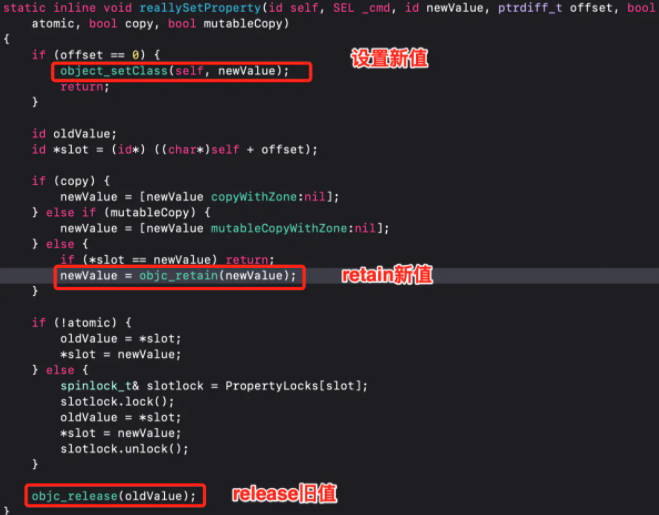
我们可以发现其方法的原理就是retain新值,release旧值,基于这段源码我们可以了解到:
-
objc_setProperty方法的目的适用于关联 上层的set方法 以及 底层的set方法,其本质就是一个接口。 -
这么设计的原因是,上层的set方法有很多,如果直接调用底层
set方法中,会产生很多的临时变量,当你想查找一个sel时,会非常麻烦 -
基于上述原因,苹果采用了适配器设计模式(即将底层接口适配为客户端需要的接口),对外提供一个接口,供上层的
set方法使用,对内调用底层的set方法,使其相互不受影响,即无论上层怎么变,下层都是不变的,或者下层的变化也无法影响上层,主要是达到上下层接口隔离的目的
3:结构体和联合体位域
联合体(union)
构造数据类型的方式有以下两种:
结构体(struct)联合体(union,也称为共用体)
1.结构体
结构体是指把不同的数据组合成一个整体,其变量是共存的,变量不管是否使用,都会分配内存。
- 优点:
存储容量较大,包容性强,且成员之间不会相互影响 - 缺点:struct内存空间的分配是粗放的,不管用不用,全分配。
2.联合体
联合体也是由不同的数据类型组成,但其变量是互斥的,所有的成员共占一段内存。而且共用体采用了内存覆盖技术,同一时刻只能保存一个成员的值,如果对新的成员赋值,就会将原来成员的值覆盖掉。
- 优点:内存使用更为精细灵活,也节省了内存空间。
- 缺点:不够“包容”。
4:源码查找isa指针
1:obj->initInstanceIsa(cls, hasCxxDtor);
inline void objc_object::initInstanceIsa(Class cls, bool hasCxxDtor) { ASSERT(!cls->instancesRequireRawIsa()); ASSERT(hasCxxDtor == cls->hasCxxDtor()); initIsa(cls, true, hasCxxDtor); }
2:initIsa(cls, true, hasCxxDtor);
inline void objc_object::initIsa(Class cls, bool nonpointer, bool hasCxxDtor) { ASSERT(!isTaggedPointer()); if (!nonpointer) { isa = isa_t((uintptr_t)cls); } else { ASSERT(!DisableNonpointerIsa); ASSERT(!cls->instancesRequireRawIsa()); isa_t newisa(0); #if SUPPORT_INDEXED_ISA ASSERT(cls->classArrayIndex() > 0); newisa.bits = ISA_INDEX_MAGIC_VALUE; // isa.magic is part of ISA_MAGIC_VALUE // isa.nonpointer is part of ISA_MAGIC_VALUE newisa.has_cxx_dtor = hasCxxDtor; newisa.indexcls = (uintptr_t)cls->classArrayIndex(); #else newisa.bits = ISA_MAGIC_VALUE; // isa.magic is part of ISA_MAGIC_VALUE // isa.nonpointer is part of ISA_MAGIC_VALUE newisa.has_cxx_dtor = hasCxxDtor; newisa.shiftcls = (uintptr_t)cls >> 3; #endif // This write must be performed in a single store in some cases // (for example when realizing a class because other threads // may simultaneously try to use the class). // fixme use atomics here to guarantee single-store and to // guarantee memory order w.r.t. the class index table // ...but not too atomic because we don't want to hurt instantiation isa = newisa; } }
3:可以看到不管!nonpointer条件是否满足,都会生成一个isa_t的类型
union isa_t { isa_t() { } isa_t(uintptr_t value) : bits(value) { } Class cls; uintptr_t bits; #if defined(ISA_BITFIELD) struct { ISA_BITFIELD; // defined in isa.h }; #endif };
4: ISA_BITFIELD宏定义,我们看到定义的是位域, 在__arm64__和__x86_64__下里面定义的变量是相同的,只是所占的字节数略微有些不同。
# if __arm64__ # define ISA_BITFIELD \ uintptr_t nonpointer : 1; \ uintptr_t has_assoc : 1; \ uintptr_t has_cxx_dtor : 1; \ uintptr_t shiftcls : 33; /*MACH_VM_MAX_ADDRESS 0x1000000000*/ \ uintptr_t magic : 6; \ uintptr_t weakly_referenced : 1; \ uintptr_t deallocating : 1; \ uintptr_t has_sidetable_rc : 1; \ uintptr_t extra_rc : 19 # elif __x86_64__ # define ISA_BITFIELD \ uintptr_t nonpointer : 1; \ uintptr_t has_assoc : 1; \ uintptr_t has_cxx_dtor : 1; \ uintptr_t shiftcls : 44; /*MACH_VM_MAX_ADDRESS 0x7fffffe00000*/ \ uintptr_t magic : 6; \ uintptr_t weakly_referenced : 1; \ uintptr_t deallocating : 1; \ uintptr_t has_sidetable_rc : 1; \ uintptr_t extra_rc : 8 endif
5:所以其实isa_t的真正结构是联合体位域,__x86_64__下,我们可以看到位域里面所有变量所占的字节总数是64位,恰好是8字节
union isa_t { Class cls; uintptr_t bits; struct { uintptr_t nonpointer : 1; uintptr_t has_assoc : 1; uintptr_t has_cxx_dtor : 1; uintptr_t shiftcls : 44; uintptr_t magic : 6; uintptr_t weakly_referenced : 1; uintptr_t deallocating : 1; uintptr_t has_sidetable_rc : 1; uintptr_t extra_rc : 8; }; };
5:isa指针位域具体信息
-
nonpointer:表示是否对 isa 指针开启指针优化, 0:纯isa指针,1:不⽌是类对象地址,isa 中包含了类信息、对象的引⽤计数等 (自定义的类nonpointer为1) -
has_assoc:关联对象标志位,0没有,1存在 -
has_cxx_dtor:该对象是否有 C++ 或者 Objc 的析构器,如果有析构函数,则需要做析构逻辑, 如果没有,则可以更快的释放对象 -
shiftcls: 存储类指针的值。开启指针优化的情况下,在 arm64 架构中有 33 位⽤来存储类指针,x86架构用44位来存储 -
magic:⽤于调试器判断当前对象是真的对象还是没有初始化的空间 -
weakly_referenced:志对象是否被指向或者曾经指向⼀个 ARC 的弱变量,没有弱引⽤的对象可以更快释放。
-
deallocating:标志对象是否正在释放内存 -
has_sidetable_rc:当对象引⽤技术⼤于 10 时,则需要借⽤该变量存储进位 -
extra_rc:当表示该对象的引⽤计数值,实际上是引⽤计数值减 1,例如,如果对象的引⽤计数为 10,那么 extra_rc 为 9。如果引⽤计数⼤于 10,则需要使⽤到下⾯的 has_sidetable_rc。
总结:
1.isa_t是一个联合体,里面的成员变量共用一段内存,成员变量之间setter方法互斥(不能同时set),所以对cls赋值的时候就不能对bits赋值,对bits赋值的时候就不能对cls赋值。
2.shiftcls是用来存储类信息的。
6:isa关联地址和类的过程
6.1: isa_t newisa(0); 初始化isa
6.2: newisa.bits = ISA_MAGIC_VALUE; 位域赋值
6.3: newisa.shiftcls = (uintptr_t)cls >> 3; class信息赋值
7:
cls与isa关联原理就是isa指针中的shiftcls位域中存储了类信息有以下几种验证方式:
【方式一】通过
initIsa方法中的代码【方式二】通过
isa指针地址与ISA_MSAK的值&来验证【方式三】通过runtime的方法
object_getClass验证【方式四】通过
位运算验证7.1:通过
initIsa代码isa_t newisa(0); 初始化isa
newisa.bits = ISA_MAGIC_VALUE; 位域赋值
newisa.shiftcls = (uintptr_t)cls >> 3; class信息赋值
7.2:通过
isa指针地址与ISA_MSAK的值&
arm64中,ISA_MASK宏定义的值为0x0000000ffffffff8ULLx86_64中,ISA_MASK宏定义的值为0x00007ffffffffff8ULL
7.3:通过runtime的方法
object_getClass验证1:#import <objc/runtime.h>
BKPerson *objc = [BKPerson alloc]; NSLog(@"%@", object_getClass(objc));2:
object_getClass源码Class object_getClass(id obj) { if (obj) return obj->getIsa(); else return Nil; }3:getIsa
inline Class objc_object::getIsa() { if (fastpath(!isTaggedPointer())) return ISA(); extern objc_class OBJC_CLASS_$___NSUnrecognizedTaggedPointer; uintptr_t slot, ptr = (uintptr_t)this; Class cls; slot = (ptr >> _OBJC_TAG_SLOT_SHIFT) & _OBJC_TAG_SLOT_MASK; cls = objc_tag_classes[slot]; if (slowpath(cls == (Class)&OBJC_CLASS_$___NSUnrecognizedTaggedPointer)) { slot = (ptr >> _OBJC_TAG_EXT_SLOT_SHIFT) & _OBJC_TAG_EXT_SLOT_MASK; cls = objc_tag_ext_classes[slot]; } return cls; }4:再查找
ISA()inline Class objc_object::ISA() { ASSERT(!isTaggedPointer()); #if SUPPORT_INDEXED_ISA if (isa.nonpointer) { uintptr_t slot = isa.indexcls; return classForIndex((unsigned)slot); } return (Class)isa.bits; #else return (Class)(isa.bits & ISA_MASK); #endif }可以知道走的是这行代码
return (Class)(isa.bits & ISA_MASK);7.4:通过
位运算验证右移3位-->>左移20位-->>右移17位
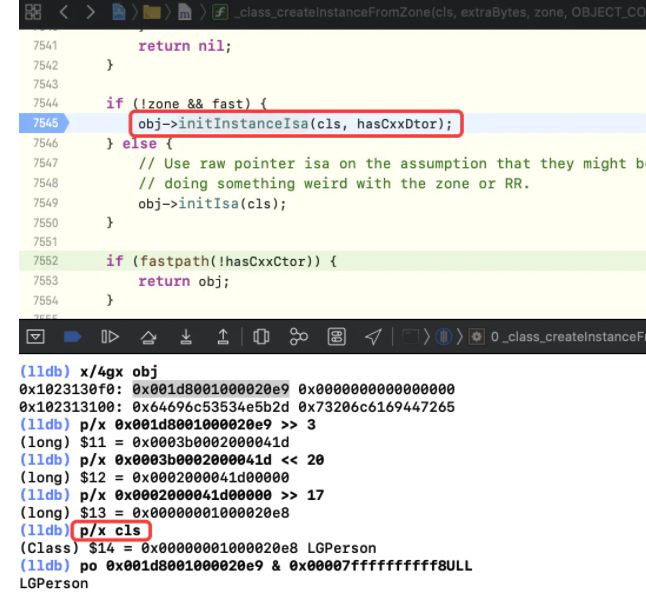
8:isa走向图
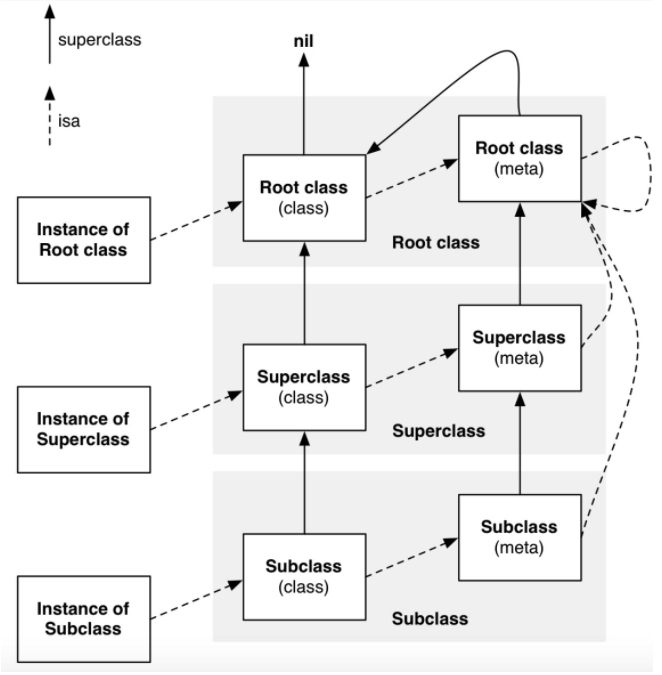
- 子类的isa走位链:
子类对象 --> 子类 --> 子元类 --> NSObject(根元类) --> NSObject(根元类,即自己) - 父类的isa走位链:
父类对象 --> 父类 --> 父元类 --> NSObject(根元类) --> NSObject(根元类,即自己) - 类的继承关系链:
子类 --> 父类 --> NSObject(根类)--> nil - 元类的继承关系链:
子元类 --> 父元类 --> 根元类 --> NSObject(根类)--> nil
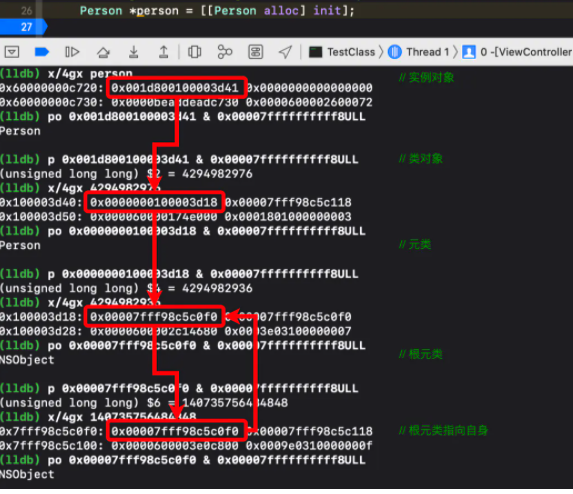
注意



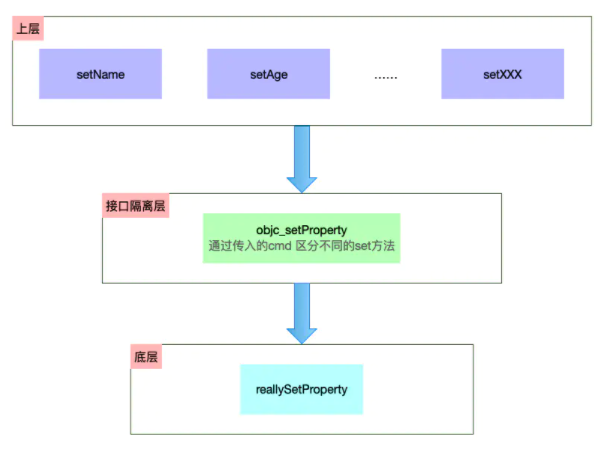



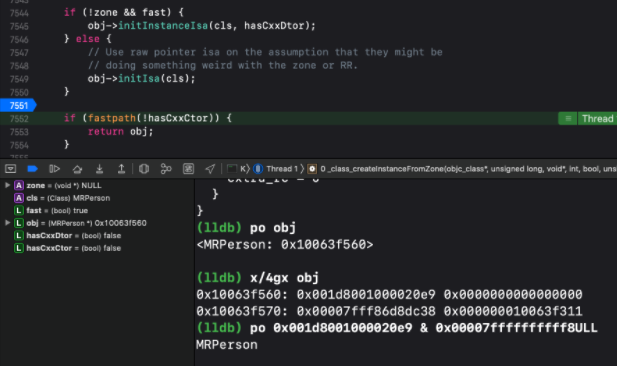



【推荐】国内首个AI IDE,深度理解中文开发场景,立即下载体验Trae
【推荐】编程新体验,更懂你的AI,立即体验豆包MarsCode编程助手
【推荐】抖音旗下AI助手豆包,你的智能百科全书,全免费不限次数
【推荐】轻量又高性能的 SSH 工具 IShell:AI 加持,快人一步
· 开发者必知的日志记录最佳实践
· SQL Server 2025 AI相关能力初探
· Linux系列:如何用 C#调用 C方法造成内存泄露
· AI与.NET技术实操系列(二):开始使用ML.NET
· 记一次.NET内存居高不下排查解决与启示
· Manus重磅发布:全球首款通用AI代理技术深度解析与实战指南
· 被坑几百块钱后,我竟然真的恢复了删除的微信聊天记录!
· 没有Manus邀请码?试试免邀请码的MGX或者开源的OpenManus吧
· 园子的第一款AI主题卫衣上架——"HELLO! HOW CAN I ASSIST YOU TODAY
· 【自荐】一款简洁、开源的在线白板工具 Drawnix